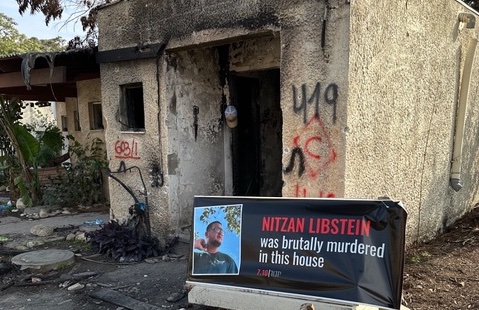Names of the victims brutally murdered as Hamas hunted Jews. Photo by Eric Mandel
As I watched the 48 minutes of raw footage of the Hamas atrocity in the Israel Defense Forces (IDF) spokesman’s office in northern Tel Aviv, Hamas’s primary motivations crystallized. It became very clear what this war is really about.
If you think it is about the Israeli-Palestinian conflict, you are right, but it is so much more than that. As Bruce Hoffman wrote in the Atlantic, “A close read of Hamas’s founding documents clearly shows its intentions.”
As scene after gruesome scene unfolds, the repeated cry of “Allahu Akbar” — “God is great” — emanates from the terrorists and, yes, from many Palestinian civilians, as they massacre, mutilate, brutalize, torture, murder and rape Jews with satisfied and joyous faces, all the while photographing their victims.
You come to the realization that this war is not just about the Israeli-Palestinian conflict but just one battle in a much greater war against radical Islamism being fought on many continents. American policy will continue to fail in the Middle East and beyond unless it acknowledges and strategizes against this complex and evolving threat, whose ideology allows the most grievous acts to be rationalized in the name of a radicalized religious perspective.
As you watch and listen to the footage of the videos and see the photographs sourced from Hamas social media, go-pro cameras and cell phones, the fanatical religious motivation comes clearly into focus as the animating force of the evil perpetrated that day.
The orgy of violence is directly attributable to jihadism, no different from what the Islamic State group, Al-Qaeda, Boko Haram, the Taliban and the Islamic Republic of Iran do in the name of a distorted faith.
After watching the film — and in my case, witnessing the massacre on Oct. 7 — you understand why Israel cannot leave Hamas as part of any future Palestinian government, as recommended by the initial Egyptian peace plan. What I saw for myself in Kfar Aza, one of the many communities devastated by Hamas, provided enough convincing evidence that no nation can allow a terrorist entity to continue threatening it from just meters away.
This also applies to Israel’s northern border, from which more than 60,000 citizens have evacuated, in addition to the 150,000 from the Gaza envelope towns and Kibbutzim. Some estimates rise to more than 300,000 internally displaced.
No democratic nation can agree to have a buffer on its side of the border with terrorists, whether Hamas or Hezbollah. Based on my interviews in Israel, nobody believes anymore that appeasement will work, or that there would be any point in allowing suitcases full of Qatari and Iranian money to support Hamas in exchange for what would be a fleeting and momentary peace.
I spoke to Israelis across the political spectrum who uniformly said Hamas cannot continue to exist or claim victory from this war, something the New York Times’s perennial Israel critic, Tom Friedman, called for in a recent article.
As former Israeli National Security Advisor Yaakov Amidror said, “We will not allow an organization to be on the other side of the fence with capabilities to attack the civilians and to launch rockets into Israel.”
You may not be able to destroy Hamas’s radical Islamic ideology that permeates the region, but you can destroy the Hamas leadership and infrastructure and hold onto territory, just as we did with the Islamic State in Iraq and Syria. Those who see the glass half-filled have pointed out that Germany and Japan did rid themselves of their radical ideologies, but only after a complete surrender — something the international community is not asking of Hamas.
Perhaps the international community is willing to sacrifice Israel for its own interests, to appease their growing anti-Israel Muslim populations, especially in the case of France. But for moral, ethical and political reasons, if there is any hope for a better future in this region, the U.S. cannot accede to international pressure to leave Hamas standing at the end of this war.
Watching the video, I realized that this massacre was about hunting Jews, no different than the Nazis. I say that deliberately in spite of the typical laziness that goes into invoking the Third Reich. Some of what the Hamas terrorists did and publicized — before Hamas supporters started taking down their social media images of the atrocities — was indeed worthy of that comparison.
The 48 minutes I watched included 139 murders — just 10 percent of those killed on that infamous day. Much of the explicit, organized sexual violence was taken out of the film due to requests from the victims’ families. Human rights and women’s groups in the U.S. that won’t condemn the massacre should be required to view all the footage.
Americans, as well as Israelis, must see this video to understand why Hamas needs to be destroyed. These brutalities are not the result over-zealous rage pertaining to a regional conflict over land. They are representative of a decades-long struggle against radical Islam in all of its forms.
Eric Mandel is director of the Middle East Political Information Network and senior security editor for the Jerusalem Report.
